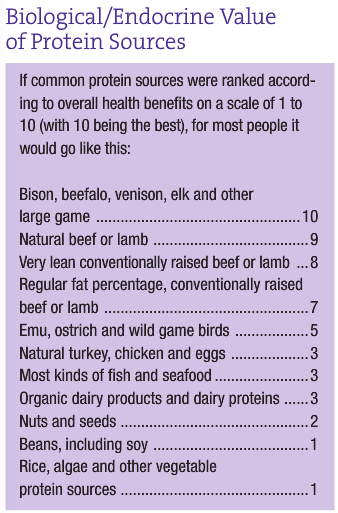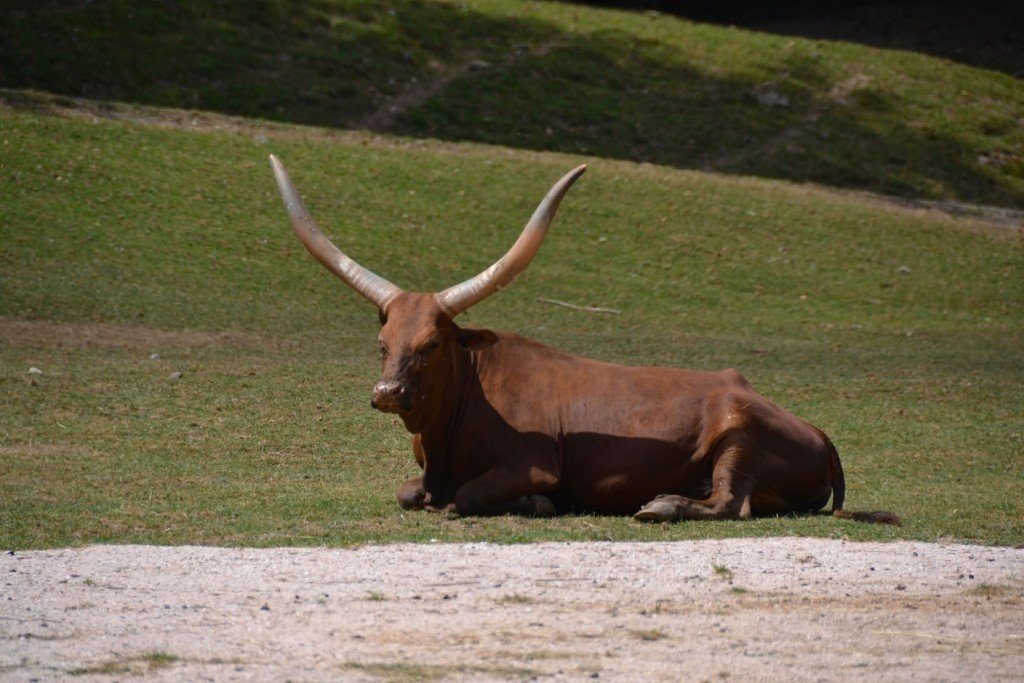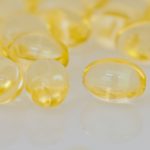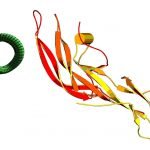Shandor Weiss, ND, LAc
The purpose of this discussion is to propose a hypothesis: Human endocrine regulation has evolved to be dependent on environmental (exogenous) sources of hormones as supplied by diet.
This hypothesis is based on the observation of many factors from a variety of disciplines. It is also based on many assumptions, theories or facts. This basis of the main hypothesis could take an entire book, or many books, to explain. In the interest of brevity, I will summarize the a priori assumptions here:
- The healthiest diet is the diet that is the most natural
- The most natural diet is what humans have evolved with, as a species
- Humans also became the human species (from early hominids to pre-humans to humans) largely because of dietary influences; and the relationship between our evolution into humans, and what constitutes a natural diet, is closely linked
- The final emergence of modern humans took place when an omnivorous hunter-gatherer diet prevailed, with a predominance of food obtained from mammals that existed in herds
- Biological natural selection of individuals diminished as a dominant factor as humans lived in larger and larger social groups. The forces of natural selection diminished and the forces of social selection increased
- This shift from natural selection to social selection coincided with the emergence of, and dependence on, agriculture and animal husbandry
- Civilization and agriculture allowed for the survival of greater numbers of people, but the health of individuals declined in direct proportion to the replacement of the original human diet with a diet based on agriculture
- This shift in the survival of numbers vs. selection for individual vitality (survivability) decreased the biological evolution, based on natural selection, of humans. In other words, humans slowed down or stopped evolving biologically as their diet and social structure changed
Therefore, to evaluate a natural human diet we have to examine the diet that made us human, the diet we evolved with as humans, and that existed before we stopped evolving biologically.
Hunter-Gatherer Diet
This most natural of diets is the hunter-gatherer diet. Biologically we are omnivores: We can eat both animal and plant food. Carnivores get almost all of their protein and nutrition from eating other animals. Herbivores rely on bacterial fermentation of plant foods to produce protein in the digestive tract. Humans do not have a digestive tract that uses fermentation to produce protein. (We do have fermentation in our guts, but the end result is gas, not protein.) Therefore, our protein must come from the food we consume.
Humans have demonstrated a remarkable flexibility and adaptive ability to survive in many environments and with a wide variety of diets. That’s one reason there is so much confusion about diets. The best way to know what is optimal for human health is to examine the diets of the healthiest humans. Almost all experts agree the healthiest humans are those who live(d) in hunter-gatherer societies. Peoples like the Cro-Magnon, early Native Americans, the Australian aborigines and the Kalahari Bushmen had almost no heart disease, cancer, senility, diabetes, tooth decay or other diseases associated with agricultural societies. They had levels of stamina and endurance only achieved by the world’s top athletes today. Those who survived infection and injury lived to an old age in a well-preserved state.
Since the beginning of agriculture about 10,000 years ago, human health has declined. Crops allow sustained food supplies for large urban populations. But food security has come at the expense of good health. Despite what we read about the health value of various grains, legumes, fruits and vegetables, the truth is that a diet based exclusively on these foods is not optimal for human health. Even the best diets based on crops are not as good as a natural hunter-gatherer diet.
Protein Intake
The protein content of hunter-gatherer diets ranged from 20% to 80%, depending on the season and food supply. Hunter-gatherers ate more meat and more food in general than modern people. They ate more food because the natural plant foods (roots, tubers, squash, bark, herbs, berries, fruits, nuts, seeds, and sea vegetables) had fewer calories than modern hybridized crops. Compared to most modern diets, a natural human diet consists of larger quantities of protein, smaller quantities of carbohydrates and larger amounts of fiber. The fat content of the hunter-gatherer diet was lower than the modern diet, but still moderate. It also had a much different profile, being low in saturated fat and high in omega fatty acids.
Large mammals were the primary source of protein humans ate as they evolved into their present biological form and function. In fact, most of the key characteristics of modern humans – including brain size and function – developed while people were eating large amounts of natural red meat. From an evolutionary and ecological point of view, this means natural red meat is the most suited for human biology. Whenever humans have had protein-deficient diets, they regressed from an evolutionary point of view. They became shorter, their brain size became smaller and they suffered from more diseases.
Most nutritionists talk about protein in terms of amino acid content (complete or incomplete) and biological value. These are important, but there are more benefits to animal protein foods than amino acids and their ratios. In other words, protein is not the only issue when looking at the health effects of high protein foods. When hunter-gatherer peoples killed large game animals, they ate the meat, glands, organs, marrow and blood. In addition to protein, these foods provided hemoglobin and essential vitamins and cofactors like B12 and NADH. More importantly, they also had significant amounts of enzymes; immune and neurohormonal regulating polypeptides; stem cells; cell signaling factors; and major hormones from all the glands of the body. Scientists keep discovering new proteins and important regulatory polypeptides. It is probable that animal foods contain important health factors that aren’t even known yet. Eating whole animal products was, and is, a natural way of getting all the immune-stimulating, anti-aging and vitality-enhancing factors they contain.
Many people are rightly concerned about synthetic hormones added to domestic animals. But natural levels of hormones in red meat is a dietary means of supplementing our own hormone levels. (Please note: In this article I am using the word “hormones” as a catch-all term to describe regulatory substances in the body. Technically, hormones are either secreted from endocrine or exocrine glands. But in actuality, there is little difference between such “official” hormones and all the other regulatory substances that may be secreted from the brain, gut, marrow, immune cells and so on. These substances, which we ingest by eating animal foods, include enzymes, products of biosynthesis (e.g., hemoglobin), immune and neurohormonal regulating polypeptides, stem cells, neurotransmitters and cell signaling factors.) In fact, we have evolved to depend on hormonal regulation from a diet rich in food from mammals. When the food supply (i.e., herd mammals) was plentiful, hunter-gatherers’ metabolism was stimulated due to the increased levels of hormones from the foods they ate. When the food supply was limited, hunter-gatherers’ metabolism slowed down. This was a natural adaptation to conserve energy during lean times.
The hypothesis of exogenous endocrine regulation is based on this observation. Humans evolved to maintain a baseline metabolic rate, as regulated by a variety of endocrine pathways, that allowed for survival in lean times. When the food/exogenous hormone supply went down, the metabolic rate went down. This created a calorie-sparing state that was not one of optimal health, but did allow for longer survival in the face of starvation. When the food supply was abundant, there was a sudden influx of exogenous hormones that up-regulated the metabolic rate.
The original hunter-gatherers were (and are) almost all blood type O. Peter D’Adamo, ND has stated that (modern) type O people are 25 times more likely to have hypothyroidism than other blood types. My clinical experience supports this finding (see the accompanying story for more). Doesn’t this seem odd? Why would our original ancestors have this apparent health defect? The answer: It is not a defect. It is a survival adaptation to environmental fluctuations in hormone supplementation from diet.
Nowadays, our metabolism is generally slower due to the lack of natural animal foods in our diet. To get the same results today people need to eat red meat and take glandular, hormonal and nutritional supplements. Scientists have found that eating 8-12 ounces of red meat per day can raise blood testosterone levels by about 50% in people with testosterone deficiencies. Similar results could probably be found if other hormone level changes from meat eating were measured. In clinical practice, I have found that my patients who previously ate little or no red meat respond better to therapy and need fewer supplements when they add significant amounts of meat to their diet. Similarly, patients who do not eat enough meat do not respond as well and need more supplements. The patients with the worst health and who are the most difficult to treat are those who have been vegans or vegetarians the longest.
Until quite recently in human history, our original way of eating had continued to some extent through various cultural cuisines. People ate blood sausage, kidney pie, tripe, sweetbreads, liver, heart, marrow and gelatin much more than they do now. Even today in some parts of the world, “civilized” people still eat this way. Among all modern cultures, the French and Chinese probably eat the most like hunter-gatherers. In fact, the Chinese eat almost everything from the animal, much as the original hunter-gatherers did. Traditional Chinese Medicine (TCM) itself makes use of almost all the endocrine glands and biologically active tissues. TCM is euphemistically known as herbal medicine, but in fact it uses hundreds of animal and human tissues as medicines.
 Blood Type and the Hunter-Gatherer Diet
Blood Type and the Hunter-Gatherer Diet
To some extent, a person’s blood type modifies the selection and value of protein sources (as described in Dr. D’Adamo’s book, Eat Right 4 Your Type). The Value List of Protein Sources is accurate for type Os, the “original” blood type. Almost all hunter-gatherer peoples were, or are, type O. But many people with type A, B or AB blood also have some degree of type O expression. As and Bs can also have an O gene, but it doesn’t show up on a blood type test. Even when As, Bs or ABs don’t have an O gene, some portion of the A or B marker can regress to type O. This occurs more during times of stress or illness. For these reasons, many type As, Bs or ABs may benefit from moving more towards the type O diet. Another reason is that there are many more biological similarities between blood types than differences.
D’Adamo says type As should not eat red meat. But for the reasons described in this main article, red meat may be an important part of the type A’s diet. For type As, it is more important to use natural and very lean red meat, and to get plenty of fiber. They also may need to eat smaller portions at one time, and use digestive aides.
In the natural human diet, people did not often have access to foods with disease-causing lectin. Either the foods were just not available or they were only available seasonally or occasionally. Therefore, problems with lectins were self-correcting. But in today’s world, we can eat the same food every day all year, year after year. This can lead to health problems if it is the wrong food we are eating all the time. On the other hand, if we eat the right food, it is only beneficial to eat it all the time.
Most people should regularly eat between 40 and 90 grams of protein a day. Some people can get by with a little less, while many need more. Pregnant women, physical laborers or athletes, and type Os may need as much as 120 grams or more a day. People who are sick, toxic or have been on low-protein diets may also need 120 grams or more per day, at least to begin with. For some people, these larger amounts may gradually be reduced as their condition improves. Forty to 90 or even 120 grams of protein a day is not a high-protein diet. It is an adequate protein diet suited to human biology. There are about 7 grams of protein in one ounce of a high-protein food like meat, fish, fowl or cheese. One egg equals about 6 grams. In order to regulate blood sugar and insulin levels, it is best to eat protein with each meal and snack.
Considering all the life-supporting nutrients in red meat, it is the protein source with the highest overall biological value to humans. In fact, eating meat from mammals is just the beginning of a natural way to maintain endocrine balance and optimal health. Incorporating glands and other tissues like marrow into the diet is a profoundly natural and effective way to maintain optimal endocrine, immune, reproductive and neurological health. It is also the original anti-aging diet. To the extent that we do not eat these foods in our diet, NDs should provide supplementation using high-quality glandular products.
 Shandor Weiss, ND started the Arura Clinic in Ashland in 1989. Licensed by the state of Oregon as an ND and acupuncturist, he also has specialty training in homeopathy, environmental and body-mind medicine. Dr. Weiss received his undergraduate degree in ecology and environmental studies from Hampshire College in Amherst, Mass., then moved to Berkeley, Calif., to study natural and holistic healing. He completed his education in Portland, graduating in 1988 from NCNM and the Oregon College of Oriental Medicine. Dr. Weiss served as a research consultant to the National Institute of Health’s Office of Alternative Medicine; has written many lay and professional articles on health; and enjoys reaching the public through lectures, teaching, radio and television. As an ND, Dr. Weiss integrates environmental medicine and an ecological model of evaluating patients as an integral part of his practice.
Shandor Weiss, ND started the Arura Clinic in Ashland in 1989. Licensed by the state of Oregon as an ND and acupuncturist, he also has specialty training in homeopathy, environmental and body-mind medicine. Dr. Weiss received his undergraduate degree in ecology and environmental studies from Hampshire College in Amherst, Mass., then moved to Berkeley, Calif., to study natural and holistic healing. He completed his education in Portland, graduating in 1988 from NCNM and the Oregon College of Oriental Medicine. Dr. Weiss served as a research consultant to the National Institute of Health’s Office of Alternative Medicine; has written many lay and professional articles on health; and enjoys reaching the public through lectures, teaching, radio and television. As an ND, Dr. Weiss integrates environmental medicine and an ecological model of evaluating patients as an integral part of his practice.




